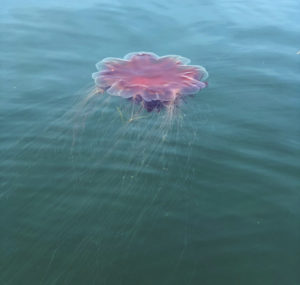The fictional detective Sherlock Holmes investigates a suspicious incident involving a jellyfish in “The Adventure of the Lion’s Mane,” a short story by Sir Arthur Conan Doyle published in 1926. Today, Cape scientists are caught up in a real-life mystery surrounding this gelatinous sea animal, as masses of the species move into local waters.

The Lion’s Mane jelly, named for its bushy outcrop of amber-colored arms and tentacles, is a common enough sight in New England, experts say, but what is different about it this year is the abundance and size of specimens seen in the waters north of and around Cape Cod — from Nantucket Sound to Pleasant Bay, across Cape Cod Bay from Marshfield to Provincetown, and up into the Gulf of Maine.
The “bloom” of Lion’s Mane in Cape waters was first detected in the late winter, said Owen Nichols, director of the fisheries research program at the Provincetown Center for Coastal Studies, who has been observing the jellies out in the field. In early March, he said, shellfishermen started noticing scores of smaller Lion’s Mane jellies in Wellfleet Harbor and the bay. As the spring progressed, the sightings continued.
The intrigue deepened over the last two weeks, when Lion’s Mane jellies of impressive proportion began to surface off the Cape tip.
“I think the real story right now that everyone is really excited about is the sheer size of the animals that are coming up,” Nichols said in a phone interview on June 26. In Provincetown, a Lion’s Mane photographed by a citizen scientist off the dinghy dock at MacMillan Pier was estimated to be about two feet wide across the bell, with tentacles extending to 10 feet.
Nichols said some of the jellies he’s seen are up to three feet wide. He hesitated to speculate how long the tentacles would be on a creature of that size.
“The maximum size they can get is eight feet across, with the tentacles extending to 200 feet,” Nichols said.
The presence of such large specimens here is a definite head-scratcher. Chris Doller, a jellyfish specialist and supervisor of changing exhibits at the New England Aquarium in Boston, says that Lion’s Manes in New England waters normally measure 10 to 12 inches wide — “about the size of a dinner plate.” The heftier specimens tend to inhabit waters far north of here, in the Arctic Ocean.
“They typically get bigger as you get colder,” Doller said.
Both Nichols and Doller suggested that a “confluence of factors” had caused the giant jellies’ southward shift.
“It’s unlikely that it’s any one thing,” said Nichols. “It could be related to changes in the pattern of ocean circulation. Despite the fact that these jellies are so big, they’re generally passive,” making it possible for swings in currents and winds to transport the jellies in from more northern waters.
Nichols also wondered if food might have something to do with it. Lion’s Mane jellyfish eat plankton and fish eggs — and fish unlucky enough to become entangled in their tentacles — but they’re also known to eat other jellies. In recent months, Nichols said, small comb jellyfish, or ctenophores, have been abundant in Cape waters, presenting a potential feast for their larger counterparts.
The giant jellies, in turn, are a boon to animals higher up in the food chain.
“The best part about Lion’s Manes is they’re a great food source for leatherback turtles,” Doller said. “A big part of [the sea turtles’] diet is gelatinous.”
Like Nichols, Doller believes that a combination of things — “ocean swells, warmer temperatures, and winds causing them to drift a little further south than where they would normally be” — may be contributing to the influx of these sea creatures.
“I’ve been at the aquarium for fifteen and a half years and this is the first time I’ve seen a bloom of Lion’s Mane like this,” Doller said.
Fortunately, Lion’s Manes are not likely to cause serious harm to swimmers who come into contact with them. Though the tentacles can deliver a sting that burns and irritates, they’re not the deadly scourge they’re made out to be in the Sherlock Holmes story, in which (spoiler alert) a man dies after taking a wrong turn in a tidal pool. (Holmes scholars think the jellyfish in “The Adventure of the Lion’s Mane” was actually a Portuguese man-of-war.)
To researchers like Nichols, the Lion’s Mane brings more puzzles than perils. When wildlife breaks out of its routine in a dramatic way like this, it’s often an indication of an underlying condition that could be rooted in deeper upheavals — such as changes in climate, he said.
“I think it’s really interesting,” Nichols said. “I want to know why they’re here. I want to know what they’re eating.
“I have a lot of questions.”



